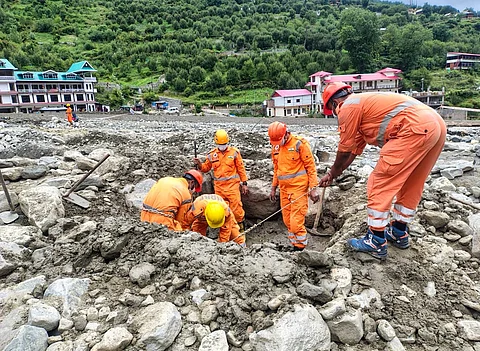

The roaring floodwaters that tore through Dharali in Uttarakhand, Kishtwar in Jammu and Kashmir, and Neelum valley in Azad Jammu and Kashmir this August did not check for passports.
The landslides that buried homes in Gilgit-Baltistan and Himachal Pradesh were indifferent to the Line of Control (LoC). As the Himalayas weep, they send a devastatingly clear message: the climate crisis, a challenge that overshadows our political disputes, has arrived, and it is hitting our shared, fragile rooftop with a fury that our divided houses cannot withstand.
For decades, the conflict over Kashmir has been framed in terms of territory, sovereignty, and security. But the recent spate of catastrophic events, detailed in harrowing reports from both sides of the border, necessitates a grim reframing. The greatest threat to the people of Kashmir, and by extension to the hundreds of millions downstream in India and Pakistan, is no longer just the soldier’s gun, but the melting glacier, the bursting cloud, and the collapsing mountain.
The evidence presented is overwhelming and terrifyingly symmetrical. In mid-August 2025, as a cloudburst claimed a family of six in Muzaffarabad and left over 500 tourists stranded in the Neelum Valley, similar tragedies were unfolding across the LoC.
In India, flash floods decimated villages, washing away roads and bridges leaving at least 56 people dead, and 300 missing in just one incident in Kishtwar. In Pakistan, the National Disaster Management Authority reported over 300 deaths since the monsoon began, with families in Bajaur and Ghizer suffering the same cruel fate as those in Uttarakhand. The names change—Ratti Gali, Kheer Ganga, Jagran Nullah—but the story is the same: a wall of water and debris, a community shattered, and a government response struggling to cope.
We have become dangerously comfortable with the term ‘cloudburst,’ using it as a convenient scapegoat. As journalist Nidhi Jamwal rightly points out, this deflects from the real issue. The mayhem is not caused by a single weather event but by a systemic failure to heed scientific warnings.
Scientists have been crying themselves hoarse about the accelerated melting of Himalayan glaciers, which could lose up to 75% of their volume by 2100. This melting creates vast, unstable glacial lakes, ticking time-bombs for Glacial Lake Outburst Floods (GLOFs). The disaster at South Lhonak Lake in Sikkim was a deadly preview. Yet, the Indian Himalayan Region remains a “data-dark zone,” a black hole of information precisely where we need it most.
This data vacuum is not a scientific accident; it is a political choice.
The very region that serves as the water tower for a billion people is one of the most militarized and least cooperative places on earth. How can we possibly create a robust early warning system for floods when the nations sharing the watershed refuse to share hydrological data in real-time, citing security concerns? How can we build climate-resilient infrastructure when resources are perpetually diverted to maintaining military positions on the Siachen Glacier, a dying relic whose melt water ironically threatens the very people it is meant to protect?
India-Pakistan Political Distrust
The political distrust runs so deep that it poisons the well of potential cooperation. Amid this unfolding environmental catastrophe, India and Pakistan remain locked in a Cold War mindset. Mutual accusations of “water aggression” persist and the Indus Water Treaty hangs in limbo. Whether these claims are fully accurate or part of a broader narrative of grievance, they underscore the toxic atmosphere.
The Indus Water Treaty, a rare example of past cooperation, is now viewed with suspicion rather than as a foundation upon which to build. This is misplaced. The Indus, Jhelum, and Chenab rivers, whose headwaters lie in the disputed territory, are the shared arteries of North India and Pakistan. A GLOF event eastern Jammu and Kashmir (Indian side) will inevitably send a devastating pulse of water into Pakistan. A degraded watershed in western Jammu and Kashmir (Pakistan side) will increase siltation and flood risk downstream in Punjab.
Continuing this conflict is an act of collective self-harm. We are fiddling while our shared home burns—or rather, drowns. The immediate and overwhelming vulnerability of the region’s population demands a radical shift in priorities. We need to move beyond blaming each other for the floods and start building a shared ark.
The first step must be to declare a “climate ceasefire.” The conflict in Kashmir must be insulated from the urgent, life-saving work of climate adaptation. This would open the door for what is desperately needed: joint mechanisms. India and Pakistan must establish a joint glaciological research canter focused on the Himalayas, pooling satellite data, field reports, and scientific expertise. They must create and operate a unified, cross-border early warning system for GLOFs and flash floods, with transparent data-sharing protocols that can save lives in Muzaffarabad as quickly as in Kishtwar.
This isn’t a call for an immediate resolution to the final political status of Kashmir—a goal that has remained elusive for 78 years. It is a pragmatic call for humanitarian and environmental cooperation as a precursor to peace. By working together to map vulnerable glacial lakes, engineer safer infrastructure, and manage watersheds, both nations can build trust, reduce risk, and demonstrate a commitment to the well-being of all people in the region, regardless of which side of a line they live on.
The mountains are speaking. The families mourning their dead, the tourists stranded by washed-out bridges, and the farmers watching their fields disappear under silt are all casualties of a dual crisis: a changing climate and an unchanging conflict.
Clinging to old animosities is no longer a viable policy it is a suicide pact. The choice is stark: continue to glare at each other across a militarized line as the waters rise, or turn together to face the storm.
Have you liked the news article?